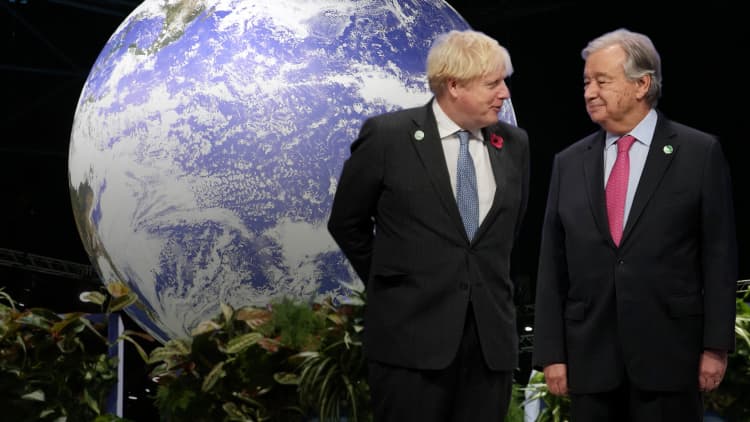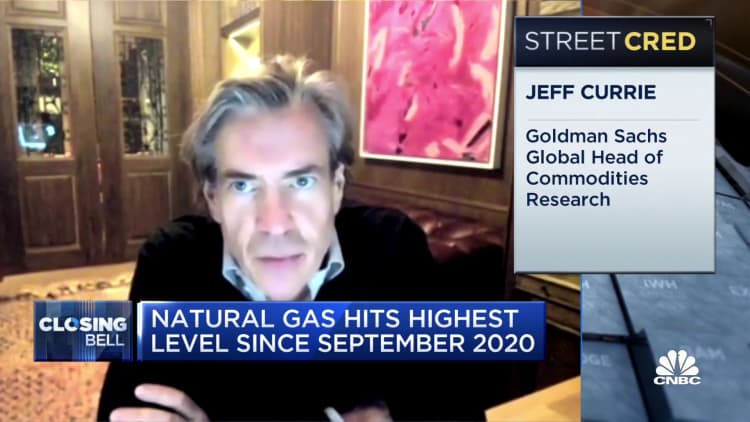The world wants to "transition" away from fossil fuels toward green energy, but the difficult reality is this: Dirty fuels are not going away — or even declining — anytime soon.
The total amount of renewable energy that's available is growing. That's good news for a world threatened by potentially devastating climate change.
But the increase in renewable energy is still lower than the increase in global energy demand overall. A "transition" from fossil fuels may come someday, but for now, renewable energy isn't even keeping pace with rising energy demand — so fossil fuel demand is still growing.
"The global power market is experiencing rapid power demand growth as markets recover from the pandemic. Despite all the capacity additions in renewables generation, the amount of power currently generated by renewables is still not enough to meet this increased demand," Matthew Boyle, manager of global coal and Asia power analytics at S&P Global Platts, told CNBC.
The global supply of renewables will grow by 35 gigawatts from 2021 to 2022, but global power demand growth will go up by 100 gigawatts over the same period, according to Boyle. Countries will have to tap traditional fuel sources to meet the rest of the demand. A gigawatt is 1 billion watts.
Projections from the International Energy Agency tell a similar story. Global electricity demand is set to rebound strongly, jumping by close to 5% this year and by 4% in 2022, according to the IEA.
The amount of electricity generated from renewables is set to increase too — by 8% this year and more than 6% in 2022, the IEA said. However, it added: "Despite these rapid increases, renewables are expected to be able to serve only around half of the projected growth in global demand in 2021 and 2022."
Overall energy shortage
At the same time, the amount spent on oil and gas has declined as prices collapsed in 2020 and the industry faced growing pressure to move away from dirty fuels. Total spending in 2021 was a little more than $350 billion – "well below" 2019 levels, said the IEA's World Energy Outlook 2021 report released last month.
"The world is not investing enough to meet its future energy needs … Transition-related spending is gradually picking up, but remains far short of what is required to meet rising demand for energy services in a sustainable way," the IEA report said.

That shortfall will only widen as economies reopen and travel resumes, with demand already spiking to pre-pandemic levels. The IEA said the rapid "but uneven" recovery from the pandemic is straining energy markets, sparking sharp rises in prices for natural gas, coal and electricity.
Already, countries are in the throes of a major energy crunch, as a gas shortage slams Europe and coal shortages pressure China and India.
That said, just because major energy companies may be cutting investment in fossil fuels doesn't mean those emissions have stopped altogether.
Speaking at the Green Horizon Summit chaired by CNBC's Julianna Tatelbaum during the COP26 climate conference in Glasgow, Scotland, BlackRock Chairman and CEO Larry Fink expressed worries that publicly traded oil companies are lowering their reportable emissions by merely selling parts of their business to private companies that are less transparent than big firms traded on public markets.
Fossil fuels as necessary backup
One problem with renewables is that many sources are at the mercy of the weather.
"You might build a lot of wind farms, you might have hydro reservoirs and and hydro generation facilities, and you might have a lot of solar panels," Anthony Yuen, head of energy strategy at Citi Research told CNBC in a phone interview. "The problem is: What if you don't have enough water, wind, or solar versus your initial planning assumption?"
Renewable energy sources tend to under-deliver during certain periods — such as for instance in the month of September, when there's less wind power generated in Europe and China, according to Boyle of S&P Global Platts.
Yuen said countries need to think through ways to ensure a reliable energy supply, and one "common ground solution" would be to use traditional fuels as a backup when renewables fail to carry through.

"We have to be more conservative, and that means two things. One is, you basically build more capacity [for renewables] so that you try to cover more," he said. "But the other point is, what are some of the backup systems? Because sometimes, you know, let's say the hydro reservoir or wind doesn't show up for days … So the battery system is probably not sufficient."
Yuen added that some "cleaner" fossil fuels such as natural gas can be used as a backup.
"Some would say that you're perpetuating fossil fuel use. But what then is the trade-off between people actually having sufficient energy or not, right?" he said. "And that means that maybe carbon capture should still be on the table until the system is reliable enough that you don't need fossil fuels."
Carbon capture refers to technology designed to capture carbon dioxide from high-emitting activities such as power generation or industrial facilities that use either fossil fuels or biomass for fuel.
What it means for climate targets
In 2021, $750 billion will be spent globally on clean energy technologies, but that "remains far below" what is required for climate targets, the IEA said.
Such spending would need to double in the 2020s to maintain temperatures "well below" a 2 degrees Celsius rise, and they'd need to more than triple to keep it to a 1.5 degrees Celsius increase.

Countries under the 2015 Paris Agreement agreed to limit the rise in global temperatures to 1.5 degrees Celsius — the threshold that scientists say could stave off the worst impact of global warming.
Getting the world on track for net-zero emissions by 2050 — a target set in the Paris Agreement — would require clean energy transition-related investment to accelerate from current levels to around $4 trillion annually by 2030, according to the IEA . That would mark an increase of more than three times the current investment.
Metals shortfall
Lithium, cobalt and nickel are metals essential to generating renewable energy, as well as for the production of electric vehicles.
UBS in a recent estimate said that demand will increase by 11 times for lithium, three times for cobalt and two times for nickel in the next decade.
"However, there is not sufficient supply to meet this demand projection based on our knowledge of known projects today," the bank said.
According to its estimates, supply deficits will emerge for lithium in 2024, cobalt in 2023 and nickel in 2021.
UBS added that current power restrictions in China will make those shortages clear.
"The [electric vehicle] supply chain is almost wholly dependent on China for upstream materials, and long-term power outages could result in shortages," the bank said in an October note. "Upstream" refers to materials needed at the production stage.
— Lucy Handley contributed to this report.





